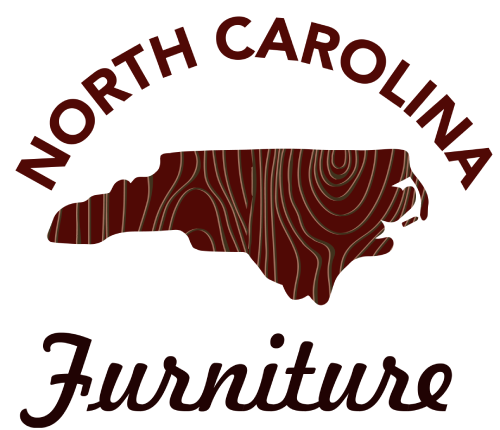Furniture made in North Carolina remains a family heritage — and large company — throughout the nation.
North Carolina had the timber — hickory, white oak, loblolly pine — along with the trained craftsmen to style it into functional pieces of artwork. And even in the present day the North Carolina railways are ready to provide. This rich history of furniture made in North Carolina has helped the state become known as America’s capital for furniture with the largest furnishings industry show called The High Point Market.
Though the domestic North Carolina furniture market has lost some steam as a result of overseas competitors, generations of North Carolina furniture family-run businesses have maintained their woodworking and roots that were built to last in the state.
How Furniture Made in North Carolina Got Its Roots
A historical tragedyput a man named John Mathias Bernhardt down the path to furniture-making. Bernhardt was orphaned as a teenager and put to work at a local sawmill as a logger. There, he worked his way up the rankings to manager, where he pushed the timber business to construct the first railway to Grandfather and Grandmother mountains, which would makeit much easier to bring from the wood harvest. In 1889, he began his own business to create chests and tables from indigenous white oak. Now today Bernhardt’scompany has been established for at least 125 years.
As much as tragedy and sheer grit to survive has built the North Carolina furniture industry into a sustainable business, innovation has also been key. In 1926, soon after the first railway reached the Blue Ridge Mountains, H.D. Fry Sr. based Hickory-Fry Furniture and started crafting upholstered couches and loveseats. Decades later, the advent of the interstate highway system enabled the company to deliver its seats quicker and more economical than previously. And today, the electronic era has obtained this third-generation business in a new way. In 2000, it’s known as Carolina Chairs and it’s became the very primary North Carolina furniture maker to market customized, handmade sofas and seats directly to clients.
North Carolina Furniture Roots Take Hold
By 1960, furniture made in North Carolina was a booming business and both manufacturers and retailers were well-established throughout the state. Yet, there was still an unmet need in Hickory’s furniture business that J.P. Mull and his daughter Lynn Lail along with her husband, Leroy, made an exceptional area to house the furniture of several regional businesses. They helped retailers and manufacturers connect with one another, and afterwards, sell to clients directly from the construction.
Over 50 decades after, lots of the companies in Hickory Furniture Mart, such as CR Laine and South Furniture, happen to be family-owned for centuries. And HFM, also, has shown its longevity — it is currently a third-generation household enterprise. Produced by Lynn and Leroy and operate by their own sons, the Lails continue a household and their family heritage.
The furniture business in North Carolina quickly became known for its exceptionally skilled artisans and enormous stands of hardwoods–has reacted to a century of struggles with a penchant for quality and built a business to last.
Rapid Growth and Modern Production Challenges
From the turn of the 21st century, extreme changes were afoot–in fabricating and afterwards in style.A huge exit of companies rushing to align production with overseas outsourcing. Many of these modern changes were due to growth and increased demand, but some plants were closed down and opportunities were passed up by other companies.
For example, The Hickory Chair Furniture Company showcases how it scaled as a company during this growth period and adapted to the modern production challenges. Itwas founded in 1911 and found its own market in the 1930s with historic reproductions. Nowadays, it creates pieces that draws contemporary and traditional tastes equally.
One modern production challenge created by the demand for North Carolina furniture was that quality became debatable. A number of manufacturers had to partner with overseas manufacturing plants to produce at the rate in demand. The issue became that some sellers overseas demonstrated dependability in their product integrity and a few did not. A challenge that shaped the North Carolina furniture businesses and type of clientele they served.
Now in the present day, historical Carolina manufacturers such as Hickory Chair hang their hats in luxury, aiming in the top 2% of customers.Allowing them to expand into both residential and commercial interior design markets.
And while some overseas producers are delivering, Hickory Chair has developed a hybrid solution to make the most of Asia’s efficacy and reduced prices. The overseas producers have in turn improved the competitive nature of the furniture industry as a whole because companies can control what parts are manufactured and imported. For example, Hickory Chair uses an overseas manufacturer for hardware and metalwork from the Philippines which Heritage Home Group owns today.
With lean manufacturing methods, the North Carolina furniture industry has positioned itself on the industry’s top edge and by overcoming these modern production challenges has built a business to last.
Other North Carolina-based businesses have used this type of dual strategy to target specific markets of consumers. By looking for design help overseas but still assembling their products here in North Carolina. Often times this looks like the furniture company operating in cooperation with multiple designers overseas to ensure they are bringing the top of the market trends back to the United States.
Furniture Made in North Carolina is Trending
The rich history of growth, struggle and sheer agility to overcome decades of obstacles, furniture made in North Carolina hasn’t lost its edge but instead become even more desirable. With more upscale design and improved manufacturing on a global scale, the variety of furniture and consumer marketing the North Carolina furniture industry can serve is at its peak. Regardless of a personal taste or style of residential or commercial building, whether a project requires innovation or cooperation between multiple parties, North Carolina’s furniture industry is built to last.

